
The Masonic Temple of Des Moines is a historic Beaux Arts style building located in Des Moines, Iowa. Constructed in 1913, it was listed on the National Register of Historic Places (NRHP) in 1997.
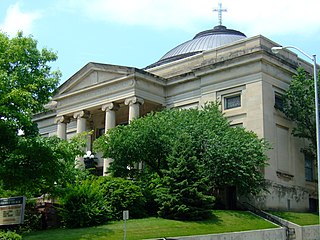
Proudfoot & Bird et al. was an American architectural firm or partnership that designed many buildings in the U.S. Midwest.

Liebbe, Nourse & Rasmussen was an architectural firm in the U.S. state of Iowa. Their Kromer Flats was built in 1905. It designed a number of buildings that are listed on the U.S. National Register of Historic Places.

The Teachout Building is an historic building located in the East Village of Des Moines, Iowa, United States. It was individually listed on the National Register of Historic Places in 1999. In 2019 the building was included as a contributing property in the East Des Moines Commercial Historic District.

The Warfield, Pratt and Howell Company Warehouse is an historic building located in downtown Des Moines, Iowa, United States. The building was built by wholesale grocer Warfield, Pratt and Howell Company. Wilson R. Warfield and John W. Howell moved their business to Des Moines in 1860 and moved to this location in 1884. William J. Pratt joined the partnership in 1897. The structure is a six-story commercial and office building that rises 93 feet (28 m) above the ground. The prominent Des Moines architectural firm of Proudfoot & Bird designed the building, and it is considered a good example of warehouse construction from the turn of the 20th century. It was completed in 1901 with an addition completed in 1909. It features load bearing brick piers, bearing walls, and wood column and girder technology on the interior. Other wholesale firms were housed in the building after 1935. It was part of a redeveloped district in the 1980s. The building was listed on the National Register of Historic Places in 1985.
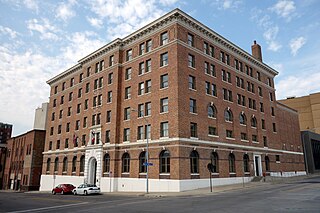
The Iowa Commission for the Blind Building is an historic building located in downtown Des Moines, Iowa. The building is a steel-framed structure covered in brick. It is a nine-story state government office building that rises 95 feet (29 m) above the ground.

The Fish and Game Pavilion and Aquarium is located in the Iowa State Fairgrounds in Des Moines, Iowa, United States. The structure was erected with financial support from the State of Iowa. It was designed by the Des Moines architectural firm of Proudfoot, Rawson & Souers. It is a masonry building with a steel frame structural system and exhibits eclectic, Italian Renaissance detail. It was originally built from 1926 to 1927 and was expanded in 1929. The building was listed as a contributing property on the National Register of Historic Places in 1987 as a part of the Iowa State Fair and Exposition Grounds and it was individually listed in 1991 as a part of the Conservation Movement in Iowa MPS.
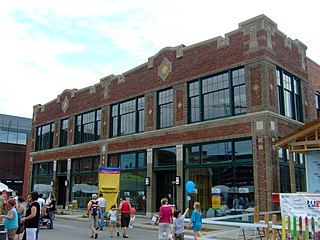
The D.S. Chamberlain Building, also known as the L. W. Taylor Motor Company and Payne Motor Company Building, is a historic building located in Des Moines, Iowa, United States. The two-story brick structure was designed by the prominent Des Moines architectural firm of Proudfoot, Bird & Rawson. Completed in 1917, it features elongated Chicago-style windows on the upper floors and simple geometric details on the cornice level that reflect the Collegiate Gothic style. The building was built as a speculative venture by Davis S. Chamberlain, who was one of the founders of his family's drug manufacturing company. It is located in the city's "Motor Row" or "Auto Row" on the west side of downtown. In 1916 there were 111 motor related firms in Des Moines that was valued at $12 million in annual trade. Both the Taylor Motor Company and the Payne Motor Company were housed in the double storefront building for many years. Other car dealerships followed. The building was listed on the National Register of Historic Places in 2007.

The Des Moines Saddlery Company Building is an historic building located in downtown Des Moines, Iowa, United States. It was built in 1881 by J. Rubelman of Muscatine, Iowa. He choose to move his operation to Des Moines because of its location on two rivers and the 13 railroads that served the city. It was one of four saddlery firms in a two block area. Rubelman's company made saddles, harnesses and leather works for 20 years. In the years since it has housed a shoe maker, rubber company, stove manufacturer, glove company, the Krispy Kone Company and the Kaplan Hat Company. The later was also the name of the restaurant that was located on the first floor.
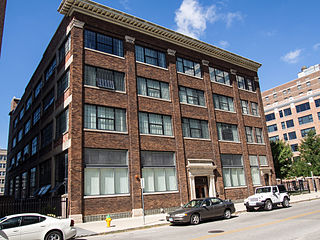
The Standard Glass and Paint Company Building, also known as 10th Street Lofts, is an historic building located in downtown Des Moines, Iowa, United States. Ashton and Ross Clemens, who were brothers, had the building built in 1913 to house their company, which was said to be the largest glass and paint business west of Chicago. Local contractor J.E. Lovejoy was responsible for its construction. It was one of several warehouse buildings on the southwest corner of the downtown area. Established by the Clemens brothers, Standard Glass and Paint Company was in existence from 1903 to 1979. It was Des Moines' leading wholesale and retail supplier of a variety of building and remodeling supplies. The company remained in this building until the mid-1920s when they moved to the Clemens Automobile Company Building, which was owned by the same family. After it sat empty until 1931 various wholesale companies occupied this building over the succeeding years. Along with the neighboring Herring Motor Car Company Building it has been converted into loft apartments. It was listed on the National Register of Historic Places in 2004.
Frank E. Wetherell (1869-1961) was an architect in the U.S. state of Iowa who worked during 1892–1931. He founded the second oldest architectural firm in the state in Des Moines, Iowa, in 1905. He worked with Roland Harrison in partnership Wetherell & Harrison. The firm designed numerous Masonic buildings.

Hallett & Rawson was an architectural partnership in Iowa. George E. Hallett and Harry Rawson were partners. Brooks, Borg & Skiles is the continuing, successor firm; its archives hold plans of the original Hallett & Rawson firm. Works by the individual architects and the firm include a number that are listed on the National Register of Historic Places.

The Des Moines Building is an historic building located in downtown Des Moines, Iowa, United States. It was built in 1930 based on the designs of the Des Moines architectural firm of Proudfoot, Rawson, Souers & Thomas. It is a combination of the Art deco and Art Moderne styles. The 14-story structure rises to a height of 190 feet (58 m). The former office building was abandoned and in May 2011 the city of Des Moines declared it a public nuisance so as to acquire it to be redeveloped. In November of the same year they sold the building for $150,000 to Des Moines Apartments, LP who developed it into 146 loft apartments. It was listed on the National Register of Historic Places in 2013. The basement is home to a recreational room as well as a workout room. The rooftop is accessible via the 14th floor and has a great 360 degree view of Des Moines. The building is also connected to the city's extensive skywalk system.

West Chester, also known as the D.S. Chamberlain House and Wesley Acres, is a historic building located in Des Moines, Iowa, United States. Designed by Boston architect William George Rantoul, it is considered an excellent example of Jacobethan Revival architecture in the city. It was featured in a couple of publications after its completion. The inspiration for the house's design were the half timbered homes in Chester, England. It features five gables and dormers on the main facade that rise above the ridged roofline and three tall chimneys with separate shafts for each flue. There are two gabled wings on the south elevation of the house.
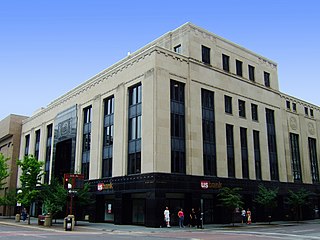
The Iowa-Des Moines National Bank Building, also known as the Valley National Bank Building and U.S. Bank, is a historic building located in downtown Des Moines, Iowa, United States. Designed by the prominent Des Moines architectural firm of Proudfoot, Rawson, Souers & Thomas, it was designed to be a 21- or 22-story building. It is one of the few downtown commercial buildings built in the Art Deco style. It is also thought to be one of the first bank buildings to put the banking room on the second floor while placing retail space on the first floor. Given its location in an area dominated by retail this made sense. This location had a bank on it since 1882 when the Des Moines National Bank built here. The present building was the result when Des Moines National Bank merged with Iowa National Bank and Des Moines Savings Bank and Trust Company in 1929. The original design for the building was a five-story base and a set-back rental office tower on top of it. The base was begun in 1931 and completed a year later. The building is composed of black polished granite on the first floor and the upper floors are Bedford stone. There is a recessed entrance in the center bay of the main facade. The fifth floor was meant to be the base of the office tower that was never built.

The Grocers Wholesale Company Building, also known as the Sears and Roebuck Farm Store, is a historic building located in Des Moines, Iowa, United States. Completed in 1916, this was the first of four warehouses built and owned by Iowa's only and most successful statewide cooperative grocery warehouse. It is possible that it was the first statewide organization of this kind in the country. The cooperative allowed independent grocers to compete against chain stores and survive wholesale grocers' surcharges. They leased their first warehouse after they organized in 1912. Each successive time the cooperative built a new warehouse it was larger and technologically more advanced than the previous one. This particular cooperative grew to include parts of four states: Iowa, southern Minnesota, northern Missouri and eastern Nebraska. They built their second warehouse in 1930 and moved out of this facility. They continued to own this building until 1968, and they leased it out to other firms. The Sears Farm Equipment Store began to occupy the building in 1937 and continued here until 1959. The cooperative became the Associated Grocers of Iowa in the late 1950s, and it continued in existence until 1985. The building was listed on the National Register of Historic Places in 2008.

The Flynn–Griffin Building, also known as the Flynn Block, Peoples' Savings Bank Building, and the Edna M. Griffin Building, is a historic building located in Des Moines, Iowa, United States. It was listed on the National Register of Historic Places in 2016.
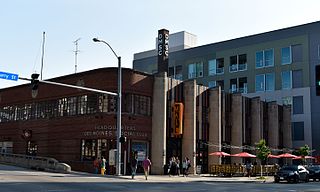
The Des Moines Fire Department Headquarters' Fire Station No. 1 and Shop Building are historic buildings located in downtown Des Moines, Iowa, United States. Completed in 1937, the facility provided a unified campus for the fire department's administration, citywide dispatch, training, maintenance, as well as the increased need for fire protective services in the commercial and warehouse districts in which the complex is located. It was designed by the Des Moines architectural firm of Proudfoot, Rawson, Brooks and Borg, and built by local contractor F.B. Dickinson & Co. The project provided jobs for local residents during the Great Depression, and 45% of its funding was provided by the Public Works Administration (PWA). The City of Des Moines provided the rest of the funds. The radio tower, which shares the historic designation with the building, was used to dispatch fire personnel from 1958 to 1978. The buildings were used by the local fire department from 1937 to 2013. It was replaced by two different facilities. The old fire station and shop building was acquired by the Des Moines Social Club, a nonprofit arts organization.

The Hippee Building, also known as the Southern Surety Building, the Savings and Loan Building, and the Midland Building, is a historic building located in downtown Des Moines, Iowa, United States. It was completed in 1913 by George B. Hippee whose father, George M. Hippee, was one of the first merchants in Des Moines. George B. developed the first interurban railway in the city and it connected Des Moines to other communities in central Iowa. The 172-foot (52 m), 12-story structure was designed by the Des Moines architectural firm of Sawyer and Watrous in the Early Commercial style. At the time of it completion, the building was Iowa's tallest skyscraper. It was used as an office building until the Aparium Hotel Group of Chicago acquired it in 2017 and began converting the building into a 138-room hotel. It was listed on the National Register of Historic Places in 2018.

The Iowa City Downtown Historic District is a nationally recognized historic district located in Iowa City, Iowa, United States. It was listed on the National Register of Historic Places in 2021. At the time of its nomination it consisted of 102 resources, which included 73 contributing buildings, one contributing site, one contributing object, 21 non-contributing buildings, and seven non-contributing objects. Eight buildings that were previously listed on the National Register are also included in the district. Iowa City's central business district developed adjacent to the Iowa Old Capitol Building and the main campus of the University of Iowa. This juxtaposition gives the area its energy with the overlap of university staff and students and the local community. The district was significantly altered in the 1970s by the city's urban renewal effort that brought about the Ped Mall, which transformed two blocks of College Street from Clinton Street to Linn Street and Dubuque Street from Burlington Street to Washington Street. It is the contributing site and the large planters/retaining walls that are original to the project are counted together as the contributing object. There are also several freestanding, limestone planters, five contemporary sculptures, and a playground area are the non-contributing objects.






















